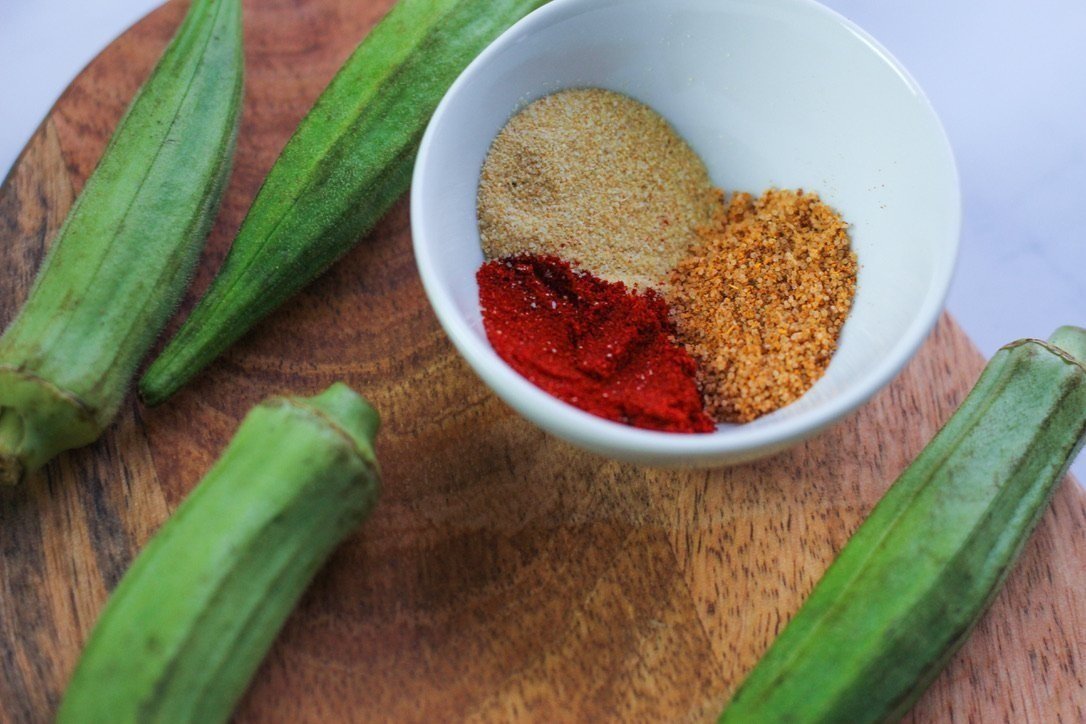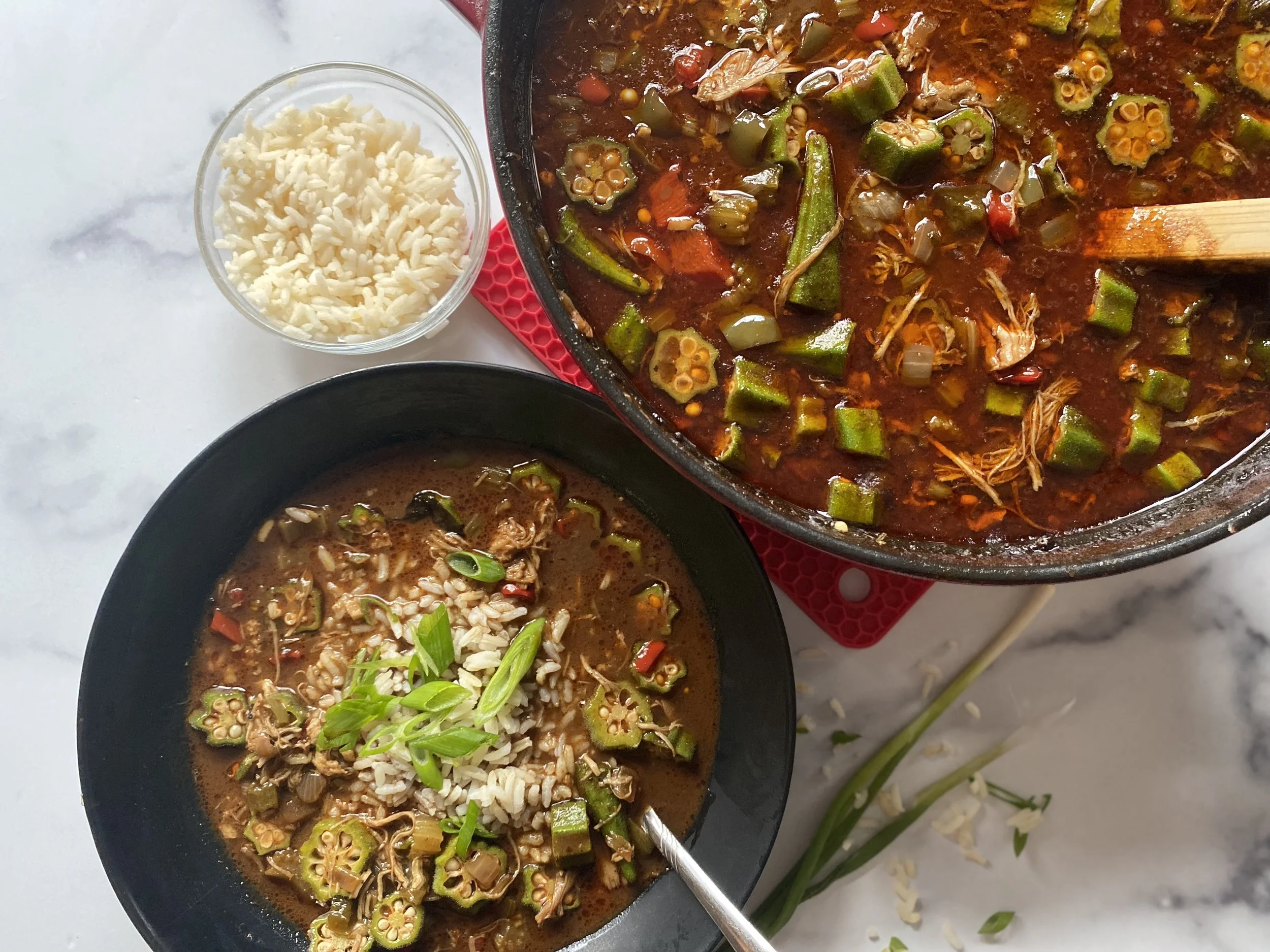Traditional Gumbo
The first fall “soup” I usually think of is gumbo. If I’m being true to the cultural practices of making gumbo, you must acknowledge that it is a dish that can be made year-round, and it won’t be too far off if you find me making a big pot of it in the middle of the summer. Although, I do see it fitting that National Gumbo Month falls in October.
Gumbo is a dish that is deep in history, culture, and flavor. It’s incredibly complex but rustic, relaxing, and easy all at the same time. The first known reference to gumbo was uncovered by a historian, Gwendolyn Midlo Hall, who found a handwritten transcription of the interrogation of a 50-year-old enslaved person named Comba in New Orleans in 1764. Suspected of being associated with other enslaved people who had stolen clothes and a pig, Comba is asked whether she had given an enslaved person named Louis un gombeau, and she replies that she did. **Serious Eats: The Real Story of Gumbo, Okra, and Filé
Gumbo has taken shape in many ways since 1764, but what remains the same is okra or filé. Okra is quite possibly my favorite vegetable and is one of the contributing factors to why I love gumbo so much. Now often used on gumbo when serving, filé is ground up sassafras leaves, and both were used to thicken gumbo. You will find most recipes use a roux now, which is the other reason why I love making gumbo and eating it.
It’s essential to create a deep rich color when making a roux. The combination of flour and fat (traditionally butter or oil) is cooked over a long period to develop deep color and flavor. Early documented recipes show tomatoes and okra stewed together to create a deep color and thickness, but of the times I’ve spent in Louisiana. With Louisiana-born chefs, I’ve been told time and time again that tomatoes don’t belong in gumbo. I agree wholeheartedly. I often find that recipes that include stewed or diced tomatoes do not allow the roux to develop long enough, and the tomatoes feel like a coverup for the misstep.
Stages of Roux for Gumbo
A good roux takes patience, but it doesn’t require much work. It also requires a cast iron or enamel-coated pot. Babysitting the pot from beginning to end is ideal. A lot of recipes will tell you to keep going until you’ve achieved the color peanut butter, and I say go until you have the color of chocolate. The flavor will be richer and deeper, and the soup will be velvetier. I promise it’s worth it.
Once the roux is down, you must follow with The Trinity. The Trinity is native to creole cooking and includes bell pepper (traditionally green), onion, and celery, and it is the base for most creole recipes.
The type of gumbo is limitless from this point, and it’s important to note that the kind of gumbo you are making is named based on what you put in it. For example, gumbo with chicken and okra in it would be called Chicken and Okra Gumbo. If you decide to make a gumbo with sausage and shrimp, it would be called a sausage and shrimp gumbo. Although gumbo with a mixture of seafood, like shrimp, crab, and crawfish, it could easily be called seafood gumbo.
Gumbo is traditionally served with white rice, but I’ve been told it can also be served with potato salad or sweet potatoes. I think it would pair perfectly with Sweet Potato Chai Bread or a buttery slice of Bacon Cornbread. No matter what you decide to put in your gumbo or what you serve it with, I encourage you to take the roux to chocolate and pay respect to the scarcity of gumbo and history.
Love Creole & Cajun cooking? Don’t forget to try my Gordon Ramsay approved Shrimp and Grits recipe or a copy of my cookbook Staples +5: 100 Simple Recipes to Make the Most of your Pantry for my recipe for Red Beans & Rice.

Traditional Gumbo
Ingredients
- 1 lb andouille sausage, sliced
- 1 cup canola oil +1 tsp, divided (Vegetable or Avocado oil can be used as well)
- 1 ½ cups all-purpose flour
- 1 large onion, diced
- 1 green bell pepper, diced
- 1 red bell pepper, diced
- 4 celery stalks, diced
- 5 cloves garlic, minced
- 2 cups okra, sliced
- 3 tbsp FoodLoveTog Young Bae or Old Bay
- 1 tbsp smoked paprika
- 1 tbsp kosher salt
- 2 tsp granulated garlic
- 1 tsp black pepper
- 2 bay leaves
- 5 sprigs of fresh thyme
- 1 tbsp Worcestershire sauce
- 2 tsp fish sauce
- 2 tsp tamari
- 8 cups of chicken stock
- 4 boneless, skinless chicken thighs
- 1 lb 16/20 shrimp cut into bite-size pieces (you could also use 30/40 shrimp, uncut)
- 1 lb jumbo lump crab meat
- 2 cups cooked long-grain rice
- 2 tbsp green onion, sliced
- Filé for dusting
Instructions
- Begin by heating a large cast iron or enamel-coated pot over medium heat. Add 1 tsp oil and the cut andouille and render until golden brown and the edges are slightly crispy. Remove the sausage from the pot.
- Reduce the heat to medium-low. Add flour and stir for 2-3 minutes, allowing the flour to absorb the andouille rendering and toasting. Add the remaining oil and stir until there are no more lumps. Continue cooking the roux until it turns into the color of chocolate, stirring occasionally—approximately 30 minutes.
- Once the roux has reached a deep brown color, carefully add the bell peppers, onions, and celery. The veggies will cause the roux to sizzle and bubble a bit. Stir until thoroughly coated by the roux. Simmer for 1 minute, then add the garlic. Continue stirring until combined. Add FoodLoveTog Young Bae, smoked paprika, granulated garlic, salt, pepper, and bay leaves. Stir until fully combined. Toss in thyme sprigs.
- Carefully add the liquid, starting with Worcestershire sauce, fish sauce, and tamari. Stir until combined, then add the chicken stock. Stir the gumbo mindfully to scrape up all the flavorful bits at the bottom of the pot. Add chicken thighs, reduce the heat to low, and allow the gumbo to cook for 2 ½ hours. Stir occasionally and skim off any oil that has risen to the top of the pot using a spoon.
- After reducing for 2 ½ hours, remove the chicken thighs, shred them with two forks and set aside. Add cut okra and cook for 10 minutes. Return the shredded chicken and rendered andouille to the pot. Stir in cut shrimp and crab meat and cook for another minute. Taste for additional salt that might be needed, only adding ¼ tsp at a time until you’ve reached your preferred flavor.
- To serve, place a mound of cooked rice in the center of a bowl. Ladle gumbo around the sides of the rice and top the rice with green onion and a dash of filé powder.
Notes
Store the leftover gumbo in an air-tight container for up to 1 week.
Gumbo can be cooled and frozen for up to 3 months. Recommend shrimp is not added until thawed and reheated in a pot over medium-low heat.
Please note that our blogs and recipes might include affiliate links, which help Tanorria earn commission on items you purchase from her recommendations at no additional cost to you.



